Posts tagged ‘forklift safety training’
Key OSHA Forklift Training Rules You Need to Know
In workplace safety, adherence to Occupational Safety and Health Administration (OSHA) standards is paramount to creating secure and healthy working conditions. Failure to comply with OSHA regulations can result in severe consequences and fines. Among OSHA’s crucial regulations are those governing forklift operations, emphasizing the importance of proper training to mitigate risks and maintain a secure work environment. This blog post provides a comprehensive overview of OSHA’s rules for forklift training, offering clarity to businesses seeking compliance.
Let’s dive into understanding OSHA’s Forklift Training Rules.
Age Requirement for Forklift Operators
OSHA mandates that individuals must be at least 18 to operate a forklift in non-agricultural operations. This age restriction is in place to ensure operators possess the maturity and responsibility necessary for safe forklift operation.
Driver’s License Requirement for Forklift Drivers
Unlike driving a car, according to OSHA requirements, forklift operators do not need a valid state driver’s license. The focus is on specialized training and certification tailored to the specific forklift used in the workplace.
Training Frequency for Forklift Operators
OSHA requires additional training in the event of a poor evaluation, changes to the work environment, or a transition to a different type of forklift. This flexibility allows businesses to tailor training schedules to their specific needs.
Recertification Interval for Forklift Drivers
OSHA requires the evaluation of every forklift operator at least once every three years to ensure that operators remain proficient in their skills and are aware of any updates or changes in safety protocols.
New Lift Trucks and Recertification
Operators do not require recertification when transitioning to a newer model of the same type of forklift. However, introducing an entirely new type of forklift necessitates thorough training before operation, ensuring operators can handle the specific characteristics of the new equipment.
Hand Pallet Jacks Certification 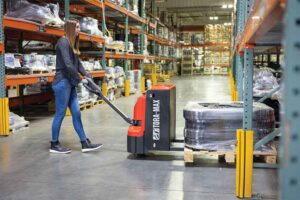
OSHA categorizes small hand pallet jacks as industrial trucks, underscoring the need for certification. Despite their compact size, Hand Pallet Jacks can cause harm if not operated correctly.
Golf Cart Operation
OSHA does not regulate golf carts. However, maintaining a safe workplace involves providing training for employees operating golf carts, emphasizing adherence to manufacturer guidelines for safe usage.
Forklift Operator Safety Training Programs
Companies are encouraged to invest in comprehensive forklift operator safety training programs. Training should cover theoretical knowledge and practical skills, ensuring operators are well-prepared for real-world scenarios.
Get Forklift Certification in LA County
We have a comprehensive operator safety training program with classroom and hands-on instruction. Using this program, our professional trainers provide your employees with the latest OSHA regulations, plus classroom and hands-on instruction on proper lift truck operation.
We provide training at our location on the 1st and 3rd Friday of every month at 8 am. We also offer Train the Trainer courses, refresher courses, and group classes at your location. We’re happy to use your equipment in your warehouse for the best results. Click here to book operator safety classes today!
Maintaining OSHA compliance is essential for safeguarding employees and the overall success of your business. Regularly check OSHA’s website for the latest rules and regulations. If you have any questions, contact us to schedule a free safety inspection to ensure a safe and compliant workplace.
Ten Ways to Make Your Warehouse Safer
Neglecting proper forklift safety protocols can lead to accidents, injuries, and property damage. Learn ten forklift operator safety tips to maintain a safe and productive work environment.
1. Proper Training and Certification
Forklift safety begins with education and training. Comprehensive forklift operator training covers equipment controls, load handling, inspection, and safety procedures. Training programs typically include classroom instruction, hands-on training, and evaluations. Anyone who operates a forklift must complete forklift operator safety training and have a certification on every different type of forklift they drive.
Toyota Material Handling Solutions provides forklift operator training in Los Angeles County. Find dates and sign up for forklift operator training here.
2. Inspect Your Forklift Before Use
A thorough pre-operational inspection is a fundamental safety practice. Before each shift, take the time to inspect the forklift for any signs of damage, leaks, or malfunctions. This inspection should cover various components, including tires, brakes, steering, lights, and safety features like horns and seatbelts. If you identify any issues during the inspection, no matter how minor they may seem, it is crucial to report them immediately to your supervisor. Regular maintenance and prompt repairs are essential for ensuring the forklift is in good working condition.
OSHA standards require daily pre-shift inspection of powered industrial trucks. You can find sample daily checklists on OSHA’s website here.
3. Wear Appropriate Personal Protective Equipment (PPE)
Personal Protective Equipment (PPE) is vital for forklift operator safety. Always wear the necessary PPE, typically a hard hat to protect your head, a high-visibility vest to enhance your visibility to others, and steel-toed shoes to safeguard your feet from potential hazards. PPE provides an additional layer of protection, reducing the risk of injury in the event of an accident or impact. It’s a simple but effective way to mitigate potential risks while operating a forklift.
4. Stay Aware of Your Surroundings
Constant awareness is a cornerstone of forklift safety. As an operator, you must always remain vigilant about your surroundings. Keep an eye out for pedestrians, other vehicles, and obstacles that might be in your path. Use the forklift’s horn and lights to enhance your visibility and alert others to your presence. Additionally, be particularly cautious in areas with restricted visibility, such as blind corners, and always yield the right of way to pedestrians.
5. Obey Speed Limits and Load Capacity
Every forklift has specific speed limits and load capacities, which the manufacturer sets. It is imperative to strictly adhere to these limits to ensure safety. Exceeding speed limits or carrying loads beyond the recommended capacity can lead to accidents, tip-overs, and loss of control. Forklift operators should observe speed limits in indoor and outdoor settings, where factors like uneven terrain, weather conditions, and varying surfaces can affect the forklift’s stability and maneuverability.
6. Operate Smoothly
Smooth operation is essential for safely handling a forklift. Start and stop the forklift smoothly to prevent sudden jolts that could dislodge the load or compromise stability. Jerky movements can damage the goods and lead to accidents. Avoid making sharp turns, sudden accelerations, or abrupt stops whenever possible. These actions can unbalance the load and make it more challenging to control the forklift.
7. Safe Load Handling
Proper load handling is critical for forklift safety. When picking up a load, it is vital to ensure it is balanced and secure on the forks. This balance minimizes the risk of the load shifting or falling while in transit. The load should be tilted slightly backward when raising it to improve stability. This prevents the load from leaning forward, which could tip the forklift. If your forklift has attachments, ensure they are installed correctly and securely before use. Always be aware of overhead clearance when stacking loads. Coinciding with overhead structures or objects can lead to significant damage and safety hazards.
8. No Horseplay Allowed
While it may seem obvious, it’s worth emphasizing that forklifts are not toys, and horseplay should never happen. Engaging in activities such as racing with other forklifts or carrying passengers endangers your safety and jeopardizes the safety of those around you. Encourage a culture of responsible behavior and clarify that safety is non-negotiable in your workplace. Setting a strong example and promoting a safe work environment will help prevent unnecessary risks and accidents.
9. Use the Parking Brake
When your forklift is unused, engage the parking brake and turn off the engine. This seemingly routine step is crucial for maintaining a safe work environment. The parking brake prevents the forklift from moving unintentionally, particularly when parked on an incline.
10. Report Incidents and Near-Misses
Reporting incidents and near-misses is vital to forklift safety. Whether you’re directly involved in an incident or simply a witness to a near-miss, it’s crucial to report these events to your supervisor immediately. Reporting serves several essential functions. It allows for a thorough investigation to identify root causes and prevent similar incidents in the future. It also helps in implementing corrective actions and improving safety measures to enhance the overall safety culture of your workplace.
It’s important to remember that forklift operators should never compromise safety for expediency or convenience. Your vigilance and commitment to safety play a significant role in preventing accidents and injuries in the workplace. Following these guidelines protects yourself and contributes to a safer, more productive, and accident-free work environment.
Stay safe, and remember: safety first, always.
We provide training in Santa Fe Springs on the 1st and 3rd Friday of every month. Sign up for forklift certification today.
Everything You Need To Know About Warehouse Safety
In any business, prioritizing workplace safety and providing comprehensive forklift training is crucial to prevent personal injuries and promote a secure environment. Establishing a robust safety program involves identifying hazards, evaluating safety policies, and ensuring regular employee training. In addition, understanding the requirements to ensure compliance with forklift training standards and avoid severe consequences and fines is crucial.
Workplace Safety Programs
Implementing safety policies and programs safeguards employees’ well-being and brings about financial and business benefits. Here are six ways a workplace safety program can positively impact your business:
- Enhance Efficiency: Untrained employees and forklift operators can be inefficient and unsafe. Providing proper training improves productivity and reduces risks.
- Minimize OSHA Penalties: A safety-related injury can lead to significant penalties, potentially reaching up to $100,000 per incident. Prioritizing workplace safety mitigates this risk.
- Mitigate Legal Liabilities: Negligence in health and safety requirements can result in lawsuits and, in some cases, criminal charges. Implementing a comprehensive safety program helps reduce the risk of civil or criminal liability.
- Reduce Worker’s Compensation Claims and Absences: Educating employees on minimizing repetitive actions and preventing strain can significantly decrease worker’s compensation claims and sick days. Healthy and pain-free employees are happier and more productive.
- Cultivate Safety Partnerships: Well-trained forklift operators and warehouse employees become proactive in accident prevention. They are adept at identifying and reporting hazards and serve as role models, promoting optimal safety behaviors within the team.
- Attract and Retain Top Talent: Valued employees seek companies that prioritize safety. A strong commitment to workplace safety demonstrates care for employees’ well-being, which resonates with top talent. Additionally, employees feel empowered to raise safety concerns and can refuse dangerous work if needed.
We offer free safety consultations if you need assistance updating your workplace safety program. Contact us to set up an appointment with a safety expert.
Complying with OSHA Forklift Certification Guidelines
Creating safe and healthy working conditions is enforced by the Occupational Safety and Health Administration (OSHA). OSHA’s website is the most reliable source for accurate and detailed information. Here are seven requirements you should know:
- Minimum Age Requirement to Operate a Forklift: Individuals must be at least 18 to operate a forklift for non-agricultural operations.
- Driver’s License Requirement: A valid state driver’s license is not necessary, according to OSHA. Instead, operators must undergo specific training and certification for the forklift they will operate in the workplace.
- Operator Safety Training Frequency: Forklift operators are only required to undergo training annually if they receive a poor evaluation or changes occur in the equipment or work environment. Unless an accident or unsafe incident occurs, annual training is not mandatory.
- Recertification Interval Frequency: OSHA mandates that every forklift operator receives an evaluation at least once every three years.
- Training for New Forklift Types: If a certified operator transitions from driving one type of forklift to a newer model of the same kind, recertification is not required. However, if an entirely different type of forklift is introduced, such as an Order Picker or Reach Truck, the operator must receive training on the new equipment before using it.
- Certification for Hand Pallet Jacks: Even though hand pallet jacks may appear small and harmless, they are powerful and potentially dangerous industrial trucks. Therefore, employees using them must be OSHA certified.
- Golf Cart Usage: While OSHA does not regulate golf carts, it is essential to maintain a safe workplace and train operators in safe golf cart operation. For proper instructions, please refer to the manufacturer’s operating guidelines.
Forklift Certification in Los Angeles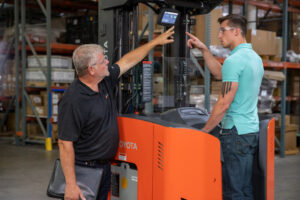
We offer comprehensive forklift operator safety training. Our program utilizes the acclaimed SAFE-Lift training developed by Toyota experts. Check out our 2023 training at our Santa Fe Springs location. Additionally, we provide Train-the-Trainer courses, refresher courses, and group classes at your facility, including classes in Spanish.
Our forklift operator safety training comprises classroom and hands-on training conducted by Toyota-certified trainers. Each attendee receives a certificate, a wallet-sized operator certification card, training booklets, and comprehensive testing.
Staying current with OSHA’s latest rules and regulations is crucial for maintaining a compliant and safe workplace. If you have questions about workplace safety programs or forklift certification in Los Angeles, contact us; a safety expert will be happy to help.
Why You Need a Forklift Certification in LA County
Forklift accidents are a severe concern for workplace safety, but it’s possible to prevent them with proper training, maintenance, and adherence to safety guidelines. Ultimately, the employer’s and the employee’s responsibility is to work together to ensure a safe workplace and reduce the risk of accidents.
OSHA FACTS AND STATISTICS
The Occupational Safety and Health Administration (OSHA) collects data on forklift safety incidents to monitor and address potential hazards. Here are some OSHA facts and statistics related to forklift accidents:
- According to OSHA, there are approximately 85 fatal forklift accidents and 34,900 serious injuries involving forklifts in the United States each year.
- OSHA estimates roughly 25% of forklift-related fatalities are from a forklift tipping over.
- The most common cause of forklift accidents is operator error, accounting for about 70%.
- OSHA requires employers to provide training to all forklift operators to help prevent accidents. However, OSHA reports that only about 1/3 of forklift operators receive the required training.
- OSHA has established strict guidelines for the operation of forklifts, including load capacity, speed limits, and maneuvering in narrow aisles. Failure to follow these guidelines can result in citations and penalties.
BENEFITS OF FORKLIFT SAFETY TRAINING 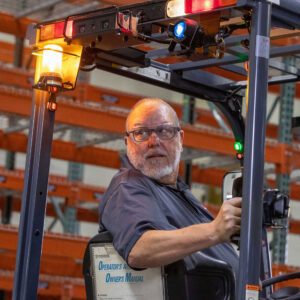
Forklift safety training is essential to maintaining a safe workplace and preventing forklift accidents. Here’s how your company can benefit from forklift safety training:
- Increased safety: Proper training can ensure that forklift operators are knowledgeable about safety procedures, equipment operation, and how to identify and avoid potential hazards.
- Compliance with regulations: OSHA requires employers to train all forklift operators. By providing training, employers can ensure that they comply with OSHA regulations and avoid potential penalties or fines.
- Reduced costs: Forklift accidents can be expensive for employers, with costs associated with property damage, lost productivity, and worker compensation claims. Employers can reduce the risk of accidents and related costs by investing in forklift safety training.
- Improved productivity: Properly trained forklift operators can work more efficiently and effectively, reducing the time and effort required to move materials around the workplace.
- Enhanced employee morale: Employees who feel safe and confident in their ability to operate forklifts are more likely to have positive attitudes towards their work and their employer.
For employers looking to maintain a safe and productive workplace, forklift safety training is an important investment.
WHAT YOU LEARN IN FORKLIFT SAFETY TRAINING
In forklift safety training, participants learn various skills and knowledge related to operating forklifts safely and efficiently. Here are some topics covered in forklift safety training:
- OSHA regulations and guidelines: Forklift safety training typically starts with an overview of OSHA regulations related to forklift operation, including requirements for training, operation, and maintenance.
- Equipment operation: Participants learn about the various parts of a forklift, how to perform a pre-operation inspection, and how to operate the forklift safely and efficiently.
- Load handling: Participants learn how to properly lift and move loads, including how to calculate weight and balance, how to secure loads, and how to stack loads safely.
- Hazard identification and avoidance: Forklift safety training teaches participants how to identify potential hazards in the workplace, such as uneven surfaces, narrow aisles, and overhead obstructions. Participants also learn how to avoid these hazards and how to respond in the event of an emergency.
- Personal protective equipment (PPE): Participants learn about the importance of using PPE while operating a forklift, including hard hats, safety glasses, and high-visibility clothing.
- Written and practical evaluations: To ensure that participants have mastered the skills and knowledge covered in the training, many forklift safety training programs include both written and practical assessments to ensure operators have learned the skills necessary to operate a forklift.
Overall, forklift safety training provides participants the skills to operate safely and efficiently while complying with OSHA regulations and guidelines.
GET FORKLIFT CERTIFICATION IN LA COUNTY
We have a comprehensive operator safety training program with classroom and hands-on instruction. Using this program, our professional trainers provide your employees with the latest OSHA regulations, plus classroom and hands-on instruction on proper lift truck operation.
We provide training at our location on the 1st and 3rd Friday of every month at 8 am. We also offer Train the Trainer courses, refresher courses, and group classes at your location. We’re happy to use your equipment in your warehouse for the best results. Click here to book operator safety classes today!
OSHA Safety Tips for Operating a Forklift
Forklifts are powerful machines used in a wide range of industrial projects. As such, forklift operators must know the safety regulations mandated by the Occupational Safety and Health Administration (OSHA). This blog post will examine some essential safety tips when operating a forklift.
Forklift Training Requirements
First, all potential forklift operators must have up-to-date training. According to OSHA, an operator must have “demonstrated the ability to safely operate [the] type(s) of powered industrial truck(s) [they] will be operating” before being allowed to use one.
Training should include classroom instruction and hands-on experience with the specific make/model of forklift they will be using. Additionally, forklift operators need refresher courses every three years or whenever an operator changes employers or job duties.
Need training or fresher courses? Sign up for our forklift operator safety training class with hands-on instruction by Toyota-certified trainers.
Pre-Operation Inspections
Pre-operation inspections are also critical to ensuring your forklift is properly working and preventing potentially dangerous accidents on the job site. Every day, an approved individual should inspect the brakes, steering mechanisms, hydraulic systems, tires, mast chains/hooks/rollers, overhead guard assemblies, and other parts before allowing anyone to operate a forklift. Additionally, components such as lights, horns, mirrors, tires, and forks should be inspected daily before use to ensure no defects that may lead to an accident or injury while on the job.
OSHA Forklift Maintenance Rules
Forklifts must be maintained by following the manufacturer’s specifications and OSHA requirements. As we mentioned above, it is essential to regularly check all parts of the forklift for wear or damage that could affect its safe operation. It is also necessary to follow all manufacturer-recommended maintenance schedules for your machine; if something does not seem right during operation (e.g., strange noises or vibrations), have it inspected immediately by a qualified mechanic.
OSHA Forklift Maintenance Records
OSHA also requires employers to keep accurate records of maintenance work on each piece of equipment to protect their employees from unnecessary risks while on the job site.
Maximum Load Limits
Another critical regulation set forth by OSHA is that operators should never exceed the maximum load limit specified by the manufacturer or risk causing an accident or injury due to an overloaded machine.
Other Safety Guidelines
For their safety and those around them, all operators should adhere to specific guidelines while using their machines—such as never raising passengers off the ground without adequate fall protection measures or traveling faster than five mph on ramps or ten mph on level surfaces. They should also avoid making sudden stops or starts and refrain from driving up slopes greater than 15%. Finally, they should always remain vigilant while operating their vehicle; distractions can lead to severe injury or death if not avoided at all costs.
Forklift Safety Products
A safety-first mindset can help everyone in your facility stay safe and avoid injuries. Read about nine forklift safety products designed to improve workplace safety here.
Operating a forklift requires skill and focus—and adhering to OSHA safety rules is paramount to any successful job site operation involving these machines. While many factors are at play regarding keeping everyone safe while using a forklift, following these tips can ensure everyone on site remains safe throughout their workday. Proper training and due diligence following these guidelines can help keep your workplace accident-free!
Six Must-Have Safety Devices for Your Forklift
Forklifts are a common sight in warehouses and factories across the country. They are essential pieces of equipment for moving heavy items around safely. However, forklifts can be dangerous if not operated properly. That is why it is important to equip your forklift with the proper safety devices. In this blog post, we will discuss six of the most important safety devices for forklifts.
- Overhead guard
- Proximity sensor
- Backup alarm
- Fork positioner
- Seat belt
- Forklift camera system
1. OVERHEAD GUARD
Every day, forklift operators have a commitment to safety and protection for themselves and those around them. Toyota forklifts have overhead guards designed to help protect operators from falling objects and other obstructions in your facility. All forklifts, no matter the brand, should be equipped with an overhead guard that meets or exceeds OSHA standards.
2. PROXIMITY SENSOR
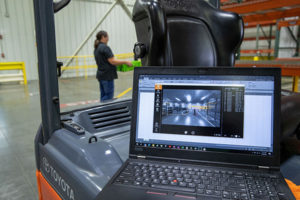
Proximity sensors are another important safety device for forklifts. They help to prevent collisions by detecting objects in the path of the forklift.
Toyota’s all-new SEnS Smart Environment Sensor™ (SEnS) pedestrian detection system can assist operators in identifying a pedestrian or object behind their forklift during a shift. SEnS uses advanced technology and proprietary algorithms to distinguish between these obstacles.
SEnS can detect objects up to 32 feet away. If within a detectible range, a buzzer and four indicator lights will alert the operator that a pedestrian or object is within a certain range of the rear of the forklift.
With Toyota’s SEnS sensor, you can program up to three detection zones with different audible and visual alarms for each zone. The frequency in which the buzzer sounds and warning lights blink increases as the pedestrian or object enters a zone closer to the rear of the forklift. Detection zones can be configured to meet various customer applications.
SEnS is available on new Toyota forklifts. It can also be retrofitted for select Toyota forklift models currently in use. SEnS works with multiple input voltages and fits a variety of applications.
The following Toyota Forklifts are currently compatible with Toyota’s SEnS. Please check with your local dealer on the availability of these products.
- 3-Wheel Electric Forklift
- Core Electric Forklift
- Core IC Cushion Forklift
- Large IC Cushion Forklift
- Core IC Pneumatic Forklift
- Mid IC Pneumatic Forklift
- Large IC Pneumatic Forklift
- Box Car Special Forklift
- Paper Roll Special Forklift
3. BACKUP ALARM
Another important safety device for forklifts is a backup alarm. This warns pedestrians and other operators when the forklift is backing up. This is especially important in busy warehouses where there is a lot of foot traffic.
4. FORK POSITIONER
Fork positioners are another must-have safety device for forklifts. They allow operators to move the forks quickly and safely from the operator seat. There are several types of fork positioners, so ask an expert to decide which one is right for you.
5. SEAT BELT
Most forklifts come standard with a seat belt. This is a critical safety feature that should always be used when operating the forklift. A seat belt keeps the operator securely in the seat in case of a sudden stop or collision and reduces the severity and incidence of injuries in the event of a tip-over.
6. FORKLIFT CAMERA SYSTEM
Operator safety is further enhanced with the forklift camera system. This system gives the operator a clear view of the area behind the forklift. It is especially helpful in busy warehouses where there is a lot of foot traffic.
These are just a few of the most important safety devices for forklifts. Be sure to equip your forklift with these devices to help keep your workplace safe. If you need help outfitting your forklifts with safety equipment, our material handling experts can help. Click here to set up a free onsite consultation.
We also offer forklift operator safety training. Sending operators to forklift training to improve safety and increase efficiency isn’t just a good idea – OSHA certification is a requirement. Keep your operators and pedestrians safe and increase productivity with professional training from Toyota Material Handling Solutions. Click here to sign up.
Nine Forklifts for Workplace Safety
According to the U.S. Department of Labor, the top five places people get injured in the warehouse are docks, forklifts, conveyors, materials and storage, and mechanical lifting and handling.
A safety-first mindset can help everyone in your facility stay safe and avoid injuries. Here are nine forklift safety products designed to improve workplace safety.
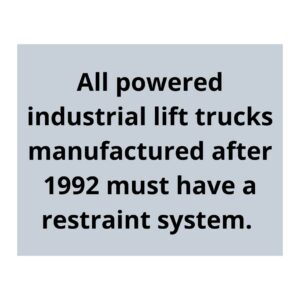
#1 Brake Lights and Headlights
OSHA requires brake lights and headlights are used in environments “where general lighting is less than two lumens per square foot.”
If standard lights are not bright enough, replace them with LED lights.
#2 Blue Lights
Blue lights aimed at the floor illuminate the front and back area of a forklift to let pedestrians and other forklift drivers know a forklift is approaching.
#3 Strobe Lights
Strobe lights placed at eye level warn others to stay alert.
#4 Fork Tilt Warning Lights
Warning lights in the cabin can alert drivers when the forks are misaligned.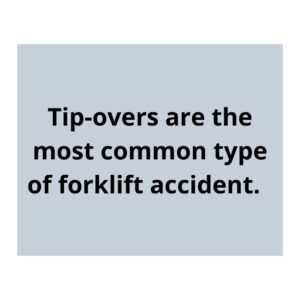
#5 Seat Belts
Seat belts keep operators secure during tip-overs, the most common type of forklift accident.
#6 Backup Alarms
Backup alarms should be installed and working on every piece of moving equipment in your facility.
#7 Blind Spot Cameras
Blind spot cameras can be beneficial to forklift operators to see around blind corners and other obstructive views.
#8 Horns
OSHA requires all forklift drivers to have access to “an operator-controlled horn, whistle, gong or another sound-producing device.” Horns allow them to alert others to blind corners or intersections where visibility is limited.
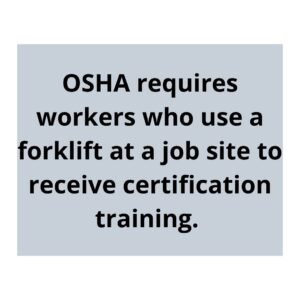
#9 Operator Safety Training
All forklift drivers must complete an operator safety training course to maintain OSHA compliance.
Safety training teaches forklift drivers about:
- A safety-first mindset
- OSHA safety rules and regulations
- Safe driving techniques
- Safety checklists
- And more
Our professional trainers teach a comprehensive operator safety training program with a combination of classroom and hands-on instruction. We have classes in Santa Fe Springs on the 1st and 3rd Friday of each month. Click here to sign up.
Our expert trainers also teach Train the Trainer courses, refresher courses, and group classes at your location. Contact us to schedule a class at your facility.
A safety-first mindset and proper forklift safety products and training can prevent accidents. Does your facility need a safety tune-up? Sign up for a complimentary safety consultation from our experienced material handling professionals.
Tips to Increase Forklift Safety
It’s no secret that forklift safety is essential for operators and pedestrians. These frightening statistics from The Occupational Safety and Health Administration (OSHA) show just how crucial it is:
- OSHA’s most recent estimates indicate that between 35,000 and 62,000 injuries involving forklifts occur annually.
- On average, 95 people are seriously injured in a forklift accident every day, and one person is killed in a forklift accident every four days.
- 36% of forklift-related deaths are pedestrians.
We hope operator and pedestrian forklift safety is high on your importance list. Learn 11 tips to help improve forklift safety at your warehouse, distribution center, or facility.
- Increase pedestrian awareness of forklifts. Add warning lights to increase forklift travel visibility, backup alarms to alert pedestrians to nearby forklift traffic, and floor tape to mark pedestrian walkways.
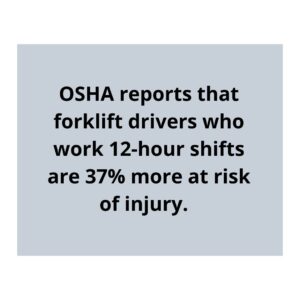 Look for forklifts with speed control features. Speed control features allow you to set the speed limits on your forklift drivers. Consider adding an aftermarket speed control kit if your forklift does not have one.
Look for forklifts with speed control features. Speed control features allow you to set the speed limits on your forklift drivers. Consider adding an aftermarket speed control kit if your forklift does not have one. - Limit forklift operators to shorter shifts. OSHA reports that forklift drivers who work 12-hour shifts are 37% more at risk of injury.
- You could also add an impact manager. An impact manager records the time and day of a forklift accident and measures the size of the impact so you can investigate and implement prevention measures. It also activates an alarm that turns off the forklift until a supervisor checks it out and enters a security code to regain function.
- Be extremely careful when tilting a raised mast. Tilting a raised forklift mast is a common cause of forklift accidents. Toyota’s Active Mast Function Control System limits forward and rear tilt speed to help prevent forward tip-overs.
- Don’t exceed the capacity of your forklift. Every forklift includes a data tag with weight limitations. Check yours to ensure you never exceed the limit.
- Make sure your forklift fleet has common safety features. Check for seatbelts, welded overhead guards, manually operated horns, operator assist grips, and skid-resistant entry and exit steps.
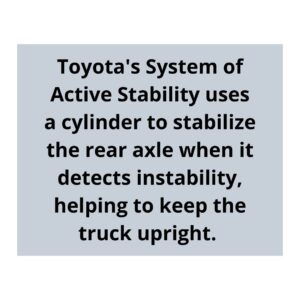
- Consider buying forklifts with advanced safety features. Toyota forklifts have advanced safety features, including its System of Active Stability, Active Mast Controls, and Automatic Forklift Levelers. These features help prevent tip-overs and other common forklift accidents. For example, Toyota’s System of Active Stability uses a cylinder to stabilize the rear axle when it detects instability, helping to keep the truck upright.
- Look for forklifts ranked #1 in safety. Toyota forklifts consistently rank #1 for safety in an independent study conducted by Peerless Research Group.
- Install mirrors and barriers. Mirrors allow forklift operators to see around blind spots, and walls can create a physical structure to help prevent serious injuries if an accident does occur.
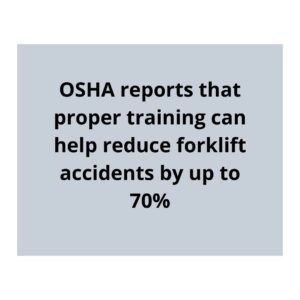 Sign up for Forklift Operator Safety Training. OSHA reports that proper training can help reduce forklift accidents by up to 70%. Our three-hour forklift operator safety training includes classroom and hands-on training by Toyota-certified trainers.
Sign up for Forklift Operator Safety Training. OSHA reports that proper training can help reduce forklift accidents by up to 70%. Our three-hour forklift operator safety training includes classroom and hands-on training by Toyota-certified trainers.
There are many ways to increase forklift safety, some depending on your specific facility. We offer complimentary safety checkups from experienced material handling professionals. Contact us to schedule a free safety consultation at your facility today.
How to Get More from Your Material Handling Provider
We do more than just rent, sell and service forklifts. We are full-service suppliers of material handling and logistical solutions. Simply put, we have the equipment, people, and expertise to help you maximize productivity and improve your bottom line. You may not know all we offer, so read on to learn seven ways we can help your business beyond forklifts.
1. Get a complimentary warehouse and pallet position analysis.
Optimize your warehouse space with a complimentary warehouse and pallet position analysis. Our experienced team of Storage and Automated Systems professionals analyze your warehouse and provide solutions to maximize your pallet storage and productivity, and ultimately — your bottom line.
Click here for two examples of the thorough complimentary analysis we provide to maximize the efficiency of your racking design, equipment selection, and overall operation.
2. Get help with pallet racking and other storage and automated systems.
Everyone wants to increase efficiency. Our experts will conduct a complimentary pallet storage analysis and help with the re-design, purchase, or installation of pallet racking and other storage and automated systems.
3. We’re your dealer for Kärcher industrial scrubbers and sweepers.
Keep your facility clean and sanitized with industrial scrubbers and sweepers. Kärcher is the world’s leading provider of efficient, resource-conserving cleaning systems, known for their performance, innovation, and quality.
4. We’re your one-stop-shop for Columbia electric utility vehicles.
Get around faster with a multi-use electric utility vehicle. Columbia has one of the most expansive electric vehicle product line-ups in the world, producing electric utility vehicles for private, commercial, and industrial use.
We carry models that move from one to 14 people, carry up to 6,000 pounds, tow up to 14,000 pounds and travel up to 18 miles per hour.
5. Buy or rent aerial platforms and boom lifts.
Reach higher with an aerial platform or boom lift. We have you covered with models from AICHI and JLG. Our inventory features built-to-last scissor lifts, telehandlers, vertical mast lifts, and boom lifts that are the perfect blend of strength, versatility, and smart technology.
Whether you want to rent or buy your aerial lift, you can count on us for quality equipment to get the job done.
6. Design a new or existing warehouse space.
Let our team of experienced material handling experts design the right warehouse storage and distribution system for your unique needs.
Want more information about optimizing your warehouse with Toyota? Read our blog post that explains the process and answers the most common questions here.
7. Get forklift safety training.
Make sure your forklift operators are OSHA compliant. Let our experts train your operators. Our forklift training is mostly online; the short hands-on portion occurs in the parking lot of our Santa Fe Springs headquarters.
Got questions about training? Click here to read our blog post with answers to common questions about forklift safety training.
As you can see, our services extend far beyond simply renting, selling, and servicing forklifts. No matter what material handling need might arise, we’ve got you covered.
Common Questions About Forklift Training
The Occupational Safety and Health Administration (OSHA) sets and enforces standards to ensure we all work in safe and healthful conditions. There are significant consequences and fines for breaking OSHA’s rules, so it’s important to know what is required to remain compliant with forklift training.
OSHA’s website is the best place for information. To help you out, here are answers to commonly asked questions about operating a forklift and forklift operator safety training.
How old do you need to be to drive a forklift?
You must be 18 years old to drive a forklift for non-agricultural operations.
Do forklift operators need a valid state driver’s license?
No. The only OSHA requirement is that operators are trained and certified to drive the specific forklift used in the workplace.
Do forklift operators need training every year?
Only if the forklift operator receives a poor evaluation or changes to the work environment or the type of forklift. Annual training is not required unless there is an accident or other unsafe incident.
How often do forklift operators need recertification?
OSHA requires an evaluation of every forklift operator at least once every three years.
Do forklift operators need to be trained every time they drive a new lift truck?
It depends. If your operator is certified to drive a 3-wheel electric forklift and replace it with a newer model, they do not need recertification. However, if you add an entirely new type of forklift to your fleet, for example, an Order Picker or Reach Truck, your forklift operator needs to be trained on the new type of forklift before they use it.
We only use small hand pallet jacks. Do our employees need to be OSHA certified to use them?
Yes. Hand pallet jacks may look small and harmless, but any industrial truck is powerful and dangerous.
We use golf carts to get around our facility. Do our employees need OSHA certification to drive them?
No. OSHA does not regulate golf carts, but you must maintain a safe workplace, including training your operators to drive a golf cart safely. We suggest you refer to the manufacturer’s operating instructions for proper use instructions.
Do you provide forklift operator safety training?
Yes, we do. Our program utilizes the SAFE-Lift training developed by experts at Toyota. Click here for a list of training dates at our location in Santa Fe Springs.
We also offer Train-the-Trainer courses, refresher courses, and group classes at your location.
What do you include in your training?
Our forklift operator safety training includes classroom and hands-on training by Toyota-certified trainers. Every attendee receives a certificate, wallet-sized operator certification card, training booklets, and comprehensive testing.
Ensure you’re OSHA compliant and check OSHA’s website often for the latest rules and regulations. It’s an essential factor in a workplace safety program to protect your employees and your bottom line.
Do you have questions we haven’t addressed? Contact us for answers!
Why You Need a Workplace Safety Program
Workplace safety and forklift training mean developing processes to eliminate personal injuries in the workplace. A well-thought–out safety program includes identifying hazards, evaluating workplace safety policies, and regularly training employees. If this sounds like standard business practice to you, then you’ll probably be surprised by the results of a 2017 survey about workplace safety.
- 17 percent of all small business employees surveyed say they never receive workplace safety training
- 25 percent of micro-businesses employees (9 or fewer employees) say they haven’t received workplace safety training
- 40 percent of small business employees say their employer does not display OSHA signage prominently, or they are not sure if it is displayed
These are shocking numbers considering OSHA has a list of employer responsibilities to provide a safe working environment. OSHA’s website is full of information so that any business can stay informed about OSHA compliance.
Safety policies and programs are essential to safeguard the well-being of employees, but are there also financial and business reasons to focus on workplace safety? The answer is yes. Here are six ways a workplace safety program can help your business.
- Improve efficiency. Employees and forklift operators without training are inefficient, not to mention unsafe.
- Lower your risk of OSHA fines and penalties. One safety-related injury can result in penalties as high as $100,000 per incident.
- Reduce your risk of civil or criminal liability. A company will most likely face a lawsuit if an employee gets hurt on the job. Even worse, it can be a crime to be negligent in health and safety requirements.
- Reduce worker’s compensation claims and sick days. Teach employees how to reduce repetitive actions to prevent unnecessary strain on the body. A pain-free employee is a happy and productive worker.
- Create safety partners. A trained forklift operator or warehouse employee will help prevent accidents. They will not only recognize and report hazards but also model optimal safety behaviors to the rest of the team.
- Attract and retain valued talent. Good employees won’t tolerate working for a company that doesn’t value safety. They will probably point out a safety issue and know they have the right to refuse dangerous work.
Need help updating your workplace safety program? Contact us for a free safety consultation and information about forklift training classes.
Forklift Safety Protects Your Bottom Line
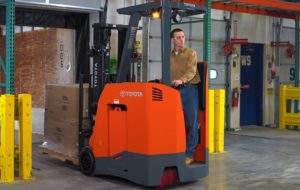 Every company has a moral and legal obligation to keep its workers safe. Many companies have an ongoing forklift safety program, but some don’t prioritize safety. Especially when money is tight. Most of the time, these companies don’t realize that spending money on safety now could save them from headaches in the long run, or they don’t understand the actual costs of a safety-related incident.
Every company has a moral and legal obligation to keep its workers safe. Many companies have an ongoing forklift safety program, but some don’t prioritize safety. Especially when money is tight. Most of the time, these companies don’t realize that spending money on safety now could save them from headaches in the long run, or they don’t understand the actual costs of a safety-related incident.
Ignoring a safety program isn’t worth the risk.
There are severe risks to forgoing a safety training program. It doesn’t take a major accident to cost money and cause significant issues for the entire company. Here is a list of potential problems you could face, even with a minor safety-related incident.
- A key employee is out due to injury
- The cost of paying and training someone new to cover the injured employee’s position
- Damage to the equipment
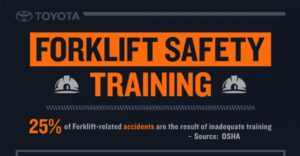 Lost production time
Lost production time - Cost to employee morale
- Cost to your business reputation
- OSHA fines
- Investigation costs
- Legal fees
- Higher insurance rates
Find out the actual costs of a workplace injury
If that list wasn’t enough to convince you of the importance of a safety program, spend a little time on OSHA’s $afety Pays tool. It will tell you exactly how much a workplace injury could cost your business. The calculator breaks down the costs of 40 types of injuries and illnesses and shows the direct and indirect costs. And to drive home the importance of safety to your bottom line, the tool calculates the additional sales revenue you would need to generate to cover these costs. Check it out. It’s an eye-opener.
There are resources to help you.
We hope you see a safety program’s value and commit to putting safety above anything else. Here are several free resources and tips to help you stay on track:
- Check OSHA’s website for free publications and information. Know OSHA’s regulations and requirements, and make sure you certify your forklift drivers.
- Develop a “safety-first” program to encourage employees to report hazards.
- Join an online safety group specific to your industry where you can ask questions, get help, and learn from others.
- Sign up for Toyota Material Handling Solutions’ forklift training classes in Santa Fe Springs or at your location.
Don’t gamble with your future. Spend time and money on safety programs and forklift training now. Not only to protect your employees but to protect your bottom line.
Toyota Material Handling Solutions proudly supports OSHA’s Safe & Sound Week.
How to Find Forklift Trip Points
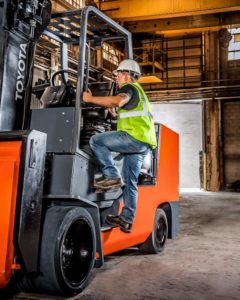
In the material handling industry, falling or tripping can turn out to be a lot more than just an embarrassing moment in front of co-workers and friends. Especially when forklifts are involved, it can lead to injury or, in worse cases, death. When we get focused on a task, sometimes we neglect to pay attention to our surroundings. Tripping hazards are all around us, so it is crucial to stay alert. Below is a shortlist of possible trip points to look out for when working with forklifts.
1. The steps on your forklift are used to enter and exit all day. Depending on the design of the forklift, tripping hazards will differ. You should always be aware of the height and location of each step. Also, look out for changes in elevation that can cause you to lose balance or get your foot caught. Use a 3 point stance when entering and exiting the forklift. Always have one foot down and grip part of the forklift with each hand for balance.
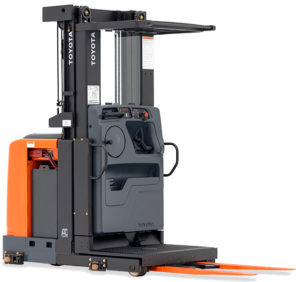
2. The accelerator, parking brake pedals, and service brakes should be kept in mind when entering and exiting a forklift. You should know their placement, whether they are on the floor or the pendulum. As a safety requirement, before exiting the forklift, make sure you engage the parking brake. This ensures that the foot-operated parking brake pedals are away.
3. The floorboard will usually vary in shape, size, and material. Always look out for changes in elevation and for abnormalities that might get your foot caught. If the tread wears off or the floorboard is damaged, replace them before operating the forklift. Improper installation can add more tripping hazards, so make sure everything is installed correctly before getting to work.
4. Forks and attachments like clamps or carpet poles on the front of a forklift usually create an elevation change at a low height that one can miss if not paying attention. Always look at the ground around you when walking around a forklift.
5. Optional equipment such as floor-mounted heaters and defrosters, audio speakers, floor stands, or mini-levers and amenity trays, can take up additional space in the compartment and can cause an operator to trip or fall if not aware of their location. Keep in mind where the optional equipment is located and based off any obstructions that are present, use the proper side when entering and exiting the forklift.
These general trip point tips are on and around forklifts. Forklifts are all designed differently, so pay attention to the points that may be present based upon your specific configuration. These points may seem obvious, but one should reinforce these principles because they can help you enhance forklift safety.
To learn more about Toyota Material Handling Solutions’ operator safety training or forklift safety tips, contact us today!
What You Need to Know About Toyota Forklift Training
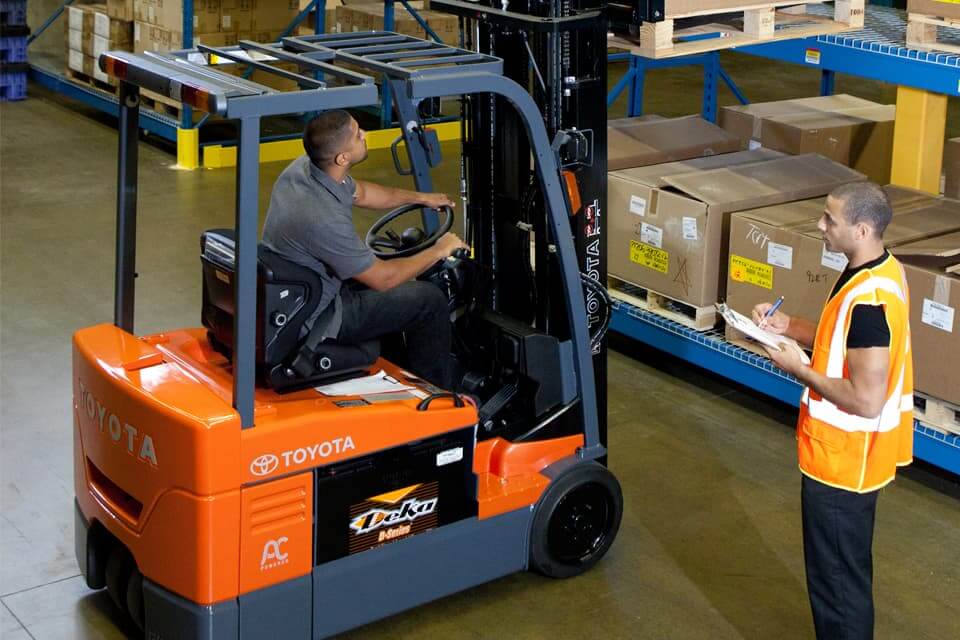
The Occupational Safety & Health Administration, or OSHA, requires anyone who operates a forklift to undergo forklift operator safety training. Any individual must also get certified on every type of forklift that they drive. If you’re wondering what this training entails, below are a few things you might learn.
Moving things across the country is the reason there are over 500,000 industrial truck operators working in the United States! Most things you see around you have needed a forklift at some point or another. Forklifts keep supply chains running, and move material all over the world.
#1: First things first: Only a trained, qualified operator should use a forklift.
#2: Entering and exiting a forklift should be treated carefully. A 3-point stance is best for both. Two hands and one foot should always be in contact with the forklift. Also, having clean hands and clean shoes will reduce your chances of slipping.
#3: A forklift is not a car. It may not look like it, but a forklift weighs a lot more than a truck or a car. Steering is different since the steering wheel is on the back of the forklift. With occasional uneven surfaces, a forklift operator must be aware of the differences between driving a car and operating a forklift. They should always use safe operating practices.
#4: Due to changes in the location of a combined center of gravity, loaded forklifts are more stable than unloaded forklifts.
#5: Data plates that show changes in load capacity should be secured to a forklift. All forklifts should have an accurate data plate. A forklift operator should follow the limitations that the data plates list. This can include lifting capacities, battery size, designated areas, and more.
#6: A responsible person should be appointed by the employer to enforce safety rules and practices. They should also correct any unsafe behavior by the operator.
#7: Because not all forklifts can operate on ramps, one must always check the correct forklift manual for instructions on ramp operation.
#8: Pedestrians should be aware of an operating forklift and the environment they may share. They play an essential part in forklift safety. They should always use designated walkways. It is their responsibility to pay attention when entering areas that forklifts are used in, such as areas where product is loaded, stored, or moved, and any areas forklifts may travel. A pedestrian should not assume the operator has seen them and should always make eye contact with the driver.
#9: All operators must perform pre-operating inspections. Transmissions, electrical systems, brakes, engines, etc. should be checked before use and make sure everything is running properly. If anything is out of order, the forklift must be tagged and out of service. You should make all repairs before using the forklift again.
#10: There’s a lot more to forklift operator training than merely taking a test. During Toyota Material Handling Solutions’ operator safety training program, trainees will learn about the following: OSHA laws governing forklift use and operation; pre-operational safety check; refueling procedures; industrial battery care; how to perform daily maintenance checks; and fundamentals of safe forklift driving. The 3-hour course concludes with a driver evaluation.
To learn more about Toyota Material Handling Solutions’ operator safety training classes or to sign up for training, contact us today!
